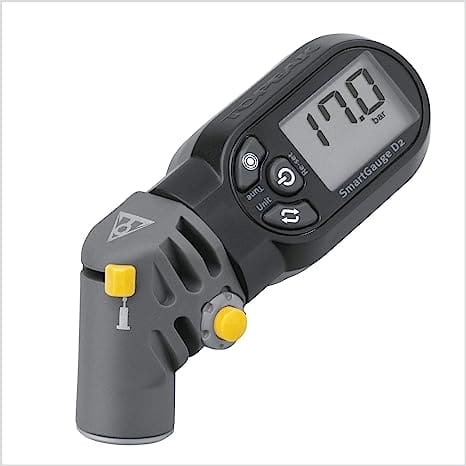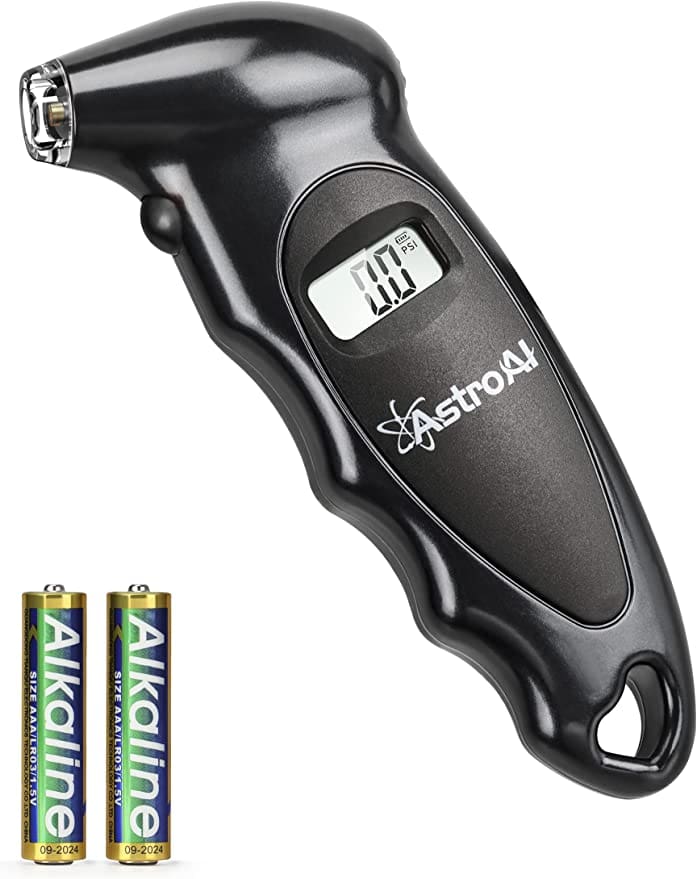
Mountain biking is an exhilarating and rewarding sport, but it can also be challenging and demanding on both rider and equipment. One often overlooked aspect of mountain biking is tire pressure. The right tire pressure can enhance your performance, comfort, and safety on the trails. In this comprehensive guide, we’ll discuss the importance of tire pressure, factors that affect it, and how to determine and maintain the optimal pressure for your specific needs. We’ll also recommend a best-selling tire pressure gauge from Amazon and provide a detailed tire pressure chart for 20 popular mountain bike models.
Why Tire Pressure Matters
Traction and Control
Tire pressure plays a vital role in traction and control on various surfaces, such as loose dirt, rocks, and mud. A tire with the proper pressure will conform to the terrain, providing better grip and stability. Tire pressure also affects control during cornering, braking, and technical descents, as it influences how the tire responds to changes in direction and load.
Comfort and Fatigue
The right tire pressure can improve shock absorption and vibration damping, leading to a more comfortable ride. Proper tire pressure can also reduce rider fatigue by minimizing the energy required to overcome trail obstacles and maintain momentum.
Tire Durability and Puncture Resistance
Maintaining optimal tire pressure can help prevent pinch flats and punctures by ensuring that the tire is properly inflated to support the rider’s weight and absorb impacts. Additionally, optimal tire pressure can extend tire life and reduce the need for frequent replacements.
Factors Affecting Optimal Tire Pressure
Rider Weight
Rider weight directly affects the ideal tire pressure, as heavier riders require higher pressure to support their weight and prevent pinch flats. Lighter riders can run lower pressures for better traction and comfort without risking tire damage.
Tire Size and Construction
Tire width, volume, and construction material all influence tire pressure recommendations. Wider and higher volume tires can generally run at lower pressures, providing more traction and shock absorption. Tire construction also plays a role, as some materials and designs can handle higher pressures better than others.
Trail Conditions and Terrain
Different trail conditions and terrain types require different tire pressures for optimal performance. For example, loose dirt and sand may require lower pressures for better grip, while rocky terrain might necessitate higher pressures to prevent pinch flats and protect the tire from sharp edges.
How to Determine Your Ideal Tire Pressure
Starting Point
As a general starting point, use the following baseline tire pressures based on tire size and rider weight:
- 2.1″-2.3″ width tires: 30-35 psi
- 2.4″-2.6″ width tires: 28-32 psi
- 2.7″-3.0″ width tires: 25-30 psi
Keep in mind that these are just starting points and should be adjusted based on personal preference and trail conditions.
Fine-Tuning
Finding the ideal tire pressure requires experimentation and personal preference. Adjust your tire pressure incrementally, testing the results on the trail. Signs that you may need to further adjust your tire pressure include poor traction, frequent punctures, or a harsh ride.
Using a Tire Pressure Gauge
A quality tire pressure gauge is essential for accurately measuring and adjusting your tire pressure. We also recommend the AstroAI Digital Tire Pressure Gauge from Amazon, which is a best-selling product with excellent reviews.

Maintaining Proper Tire Pressure
Regular Checks and Adjustments
Regularly checking and adjusting your tire pressure before each ride is important. Temperature changes and altitude can affect tire pressure, so be mindful of these factors when preparing for a ride.
Tubeless Tires and Sealant
Using tubeless tires can offer several benefits for mountain biking, including the ability to run lower pressures without the risk of pinch flats. Tire sealant can help maintain consistent tire pressure and reduce the likelihood of punctures.
Mountain Bike Tire Pressure Chart
Here’s a detailed tire pressure chart for 20 popular mountain bike models, providing a starting point for determining the optimal pressure based on rider weight:
| Bike Model | 120-140 lbs | 140-160 lbs | 160-180 lbs | 180-200 lbs | 200-220 lbs | 220-240 lbs |
|---|---|---|---|---|---|---|
| Specialized Stumpjumper | 25-28 psi | 28-30 psi | 30-32 psi | 32-34 psi | 34-36 psi | 36-38 psi |
| Santa Cruz Bronson | 24-27 psi | 27-29 psi | 29-31 psi | 31-33 psi | 33-35 psi | 35-37 psi |
| Trek FuelEX | 25-28 psi | 28-30 psi | 30-32 psi | 32-34 psi | 34-36 psi | 36-38 psi |
| Yeti SB130 | 24-27 psi | 27-29 psi | 29-31 psi | 31-33 psi | 33-35 psi | 35-37 psi |
| Giant Trance | 25-28 psi | 28-30 psi | 30-32 psi | 32-34 psi | 34-36 psi | 36-38 psi |
| Cannondale Habit | 24-27 psi | 27-29 psi | 29-31 psi | 31-33 psi | 33-35 psi | 35-37 psi |
| Scott Genius | 25-28 psi | 28-30 psi | 30-32 psi | 32-34 psi | 34-36 psi | 36-38 psi |
| Pivot Mach 6 | 24-27 psi | 27-29 psi | 29-31 psi | 31-33 psi | 33-35 psi | 35-37 psi |
| Ibis Ripmo | 25-28 psi | 28-30 psi | 30-32 psi | 32-34 psi | 34-36 psi | 36-38 psi |
| Orbea Occam | 24-27 psi | 27-29 psi | 29-31 psi | 31-33 psi | 33-35 psi | 35-37 psi |
| Rocky Mountain Altitude | 25-28 psi | 28-30 psi | 30-32 psi | 32-34 psi | 34-36 psi | 36-38 psi |
| Norco Sight | 24-27 psi | 27-29 psi | 29-31 psi | 31-33 psi | 33-35 psi | 35-37 psi |
| Devinci Troy | 25-28 psi | 28-30 psi | 30-32 psi | 32-34 psi | 34-36 psi | 36-38 psi |
| Kona Process | 24-27 psi | 27-29 psi | 29-31 psi | 31-33 psi | 33-35 psi | 35-37 psi |
| YT Jeffsy | 25-28 psi | 28-30 psi | 30-32 psi | 32-34 psi | 34-36 psi | 36-38 psi |
| Nukeproof Mega | 24-27 psi | 27-29 psi | 29-31 psi | 31-33 psi | 33-35 psi | 35-37 psi |
| Mondraker Foxy | 25-28 psi | 28-30 psi | 30-32 psi | 32-34 psi | 34-36 psi | 36-38 psi |
| Commencal Meta AM | 24-27 psi | 27-29 psi | 29-31 psi | 31-33 psi | 33-35 psi | 35-37 psi |
| Intense Primer | 25-28 psi | 28-30 psi | 30-32 psi | 32-34 psi | 34-36 psi | 36-38 psi |
| BMC Speedfox | 24-27 psi | 27-29 psi | 29-31 psi | 31-33 psi | 33-35 psi | 35-37 psi |
| Cube Stereo | 25-28 psi | 28-30 psi | 30-32 psi | 32-34 psi | 34-36 psi | 36-38 psi |
| Marin Rift Zone | 24-27 psi | 27-29 psi | 29-31 psi | 31-33 psi | 33-35 psi | 35-37 psi |
Remember, this chart serves as a starting point, and you should fine-tune your tire pressure based on personal preferences and trail conditions.
Conclusion
Tire pressure is a crucial aspect of mountain biking that affects performance, comfort, and safety. By understanding the factors that influence tire pressure
Related Articles
Thank you for exploring Mountain Biking Tire Pressure – A Comprehensive Guide to Optimal Performance! We hope it provided valuable information to enhance your biking experience. If you’re looking for more insights and tips, consider checking out these 5 related posts:
- Best Beginner’s Guide to Mountain Biking ↗
- Best Mountain Bike Maintenance Tips ↗
- Glossary Term: Mountain Biking ↗
- Glossary Term: Mountain Bike ↗
- Glossary Term: Road Bike ↗
Keep exploring and enjoy your mountain biking adventures!
